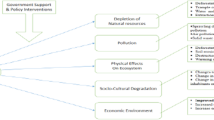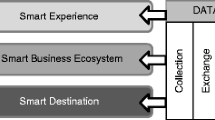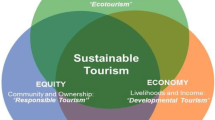Abstract
Since the 1980s, toponymy studies in Western societies has shifted away from traditional to critical paradigm, which is focused on political and cultural conflicts involved in place-(re)naming. But Chinese toponymist has paid little attention to this turning. City-renaming for tourism promotion or place marketing and stakeholders’ resulting responses in the context of China’s special ideology and tourism flourish will be good materials for critical toponymy studies. By field observation and interpretation on online texts, this article outlined the space–time process of city-renaming practices and their effects both positive and negative on touristic matters such as destination and resources, outside tourists and local habitants as well as neighbourhood relationship, dissected the renaming process of two typical tourist cities and summarized the traits of tourism placename field (TPF) by focusing on stakeholders’ responses to city-renaming practices referring to Bourdieu’s Field Theory. It found that, appropriate renaming can improve cities’ popularity at low-cost and high-efficiency, inappropriate one may do harm to destination, resource, tourists, locals and neighbourhood relationship. There existed variant responses to official renaming-decisions owing to stakeholders’ various habitus and capital conditions . TPF in China was dominated by governmental hegemony and economic priorities, which is the determinant that other sorts of capital in toponyms should yield to economic capital. However, a head-on boycott launched by other stakeholders will occur if renaming causes their direct economic loss rather than be passive victims.

Source Mapped by the author using ArcGIS10.3

Source Mapped by the author using ArcGIS10.3

Source Mapped by the author using ArcGIS10.3

Source Mapped by the author using ArcGIS10.3
Similar content being viewed by others
References
Alderman, D. H. (2003). Street names and the scaling of memory: The politics of commemorating Martin Luther King, Jr within the African American community. Area, 35(2), 163–173.
Alderman, D. H., Benjamin, S. K., & Scheider, P. P. (2012). Transforming Mount Airy into Mayberry: Film-induced tourism as place-making. Southeastern Geographer, 52(2), 212–239.
Alderman, D. H., & Inwood, J. (2013). Street naming and the politics of belonging: Spatial injustices in the toponymic commemoration of Martin Luther King Jr. Social and Cultural Geography, 14(2), 211–233.
Anholt, S. (2007). Competitive identity: The new brand management for nations, cities and regions. Journal of Brand Management, 14(6), 474–475.
Ashworth, G. J. (2009). The instruments of place branding: How is it done? European Spatial Research and Policy, 16(1), 9–22.
Azaryahu, M. (2011). The critical turn and beyond: The case of commemorative street naming. ACME: An International E-Journal for Critical Geographies, 10(1), 28–33.
Azaryahu, M., & Kook, R. (2002). Mapping the nation: Streets names and Arab-Palestinian identity: Three case studies. Nations and Nationalism, 8(2), 195–213.
Blomley, N. (2005). Remember property. Progress in Human Geography, 29(2), 125–127.
Bourdieu, P., & Wacquant, L. D. (1992). An invitation of reflective sociology. Chicago: University of Chicago Press.
Cardoso, R. V., & Meijers, E. J. (2017). The metropolitan name game: The pathways to place naming shaping metropolitan regions. Environment and Planning A, 49(3), 703–721.
Chang, H. H. (2013). Wayfinding strategies and tourist anxiety in unfamiliar destinations. Tourism Geographies, 15(3), 529–550.
Church, A., & Penny, S. (2013). Power, space and the new stadium: The example of Arsenal Football Club. Sport in Society, 16(6), 819–834.
Clark, I. D. (2009). Naming sites: Names as management tools in indigenous tourism sites—an Australian case study. Tourism Management, 30(1), 109–111.
Cohen, S. B., & Kliot, N. (1992). Place-names in Israel’s ideological struggle over the administered territories. Annals of the Association of American Geographers, 82(4), 653–680.
Gill, G. (2005). Changing symbols: The renovation of Moscow place names. Russian Review, 64(3), 480–503.
Giraut, F., & Houssay-Holzschuch, M. (2016). Place naming as dispositif: Toward a theoretical framework. Geopolitics, 21(1), 1–21.
Guyot, S., & Seethal, C. (2007). Identity of place, places of identities: Change of place names in post-apartheid South Africa. South African Geographical Journal, 89(1), 55–63.
Kadmon, N. (2004). Toponymy and geopolitics: The political use—and misuse—of geographical names. The Cartographic Journal, 41(2), 85–87.
Karimi, A. (2016). Street fights: The commodification of place names in Post-Taliban Kabul City. Annals of the American Association of Geographers, 106(3), 1–16.
Kolás, A. (2004). Tourism and the making of place in Shangri-la. Tourism Geographies, 6(3), 262–279.
Kostanski, L. (2011). Toponymic dependence research and its possible contribution to the field of place branding. Place Branding and Public Diplomacy, 7(1), 9–22.
Li, P., & Feng, D. (2015). The politics of place naming: Changing place name and reproduction of meaning for Conghua Hotspring. Human Geography, 30(2), 58–64. (in Chinese).
Light, D. (2014). Tourism and toponymy: Commodifying and consuming place names. Tourism Geographies, 16(1), 141–156.
Light, D., & Young, C. (2014). Habit, memory, and the persistence of socialist-era street names in postsocialist Bucharest, Romania. Annals of the Association of American Geographers, 104(3), 668–685.
Light, D., & Young, C. (2015). Toponymy as commodity: Exploring the economic dimensions of urban place names. International Journal of Urban and Regional Research, 39(3), 435–450.
Liu, B., & Zhu, H. (2014). Naming and renaming: A critical study on Guangzhou Metro Stations. Scientia Geographic Sinica, 34(9), 1139–1144. (in Chinese).
Mair, H. (2009). Searching for a new enterprise: Themed tourism and the re-making of one small Canadian community. Tourism Geographies, 11(4), 462–483.
Masuda, J. R., & Bookman, S. (2016). Neighbourhood branding and the right to the city. Progress in Human Geography. doi:10.1177/0309132516671822.
McCarville, R., & Garrow, G. (1993). Name selection and response to a hypothetical recreation program. Journal of Park & Recreation Administration, 11(3), 15–27.
Moilanen, T., & Rainisto, S. (2009). How to brand nations, cities and destinations: A planning book for place branding. New York: Palgrave.
Morgan, M. (2006). State park names: Implications for tourism marketing. Tourism Analysis, 11(1), 71–74.
Myers, G. A. (2009). Naming and placing the other: Power and the urban landscape in Zanzibar. In L. D. Berg & J. Vuolteenaho (Eds.), Critical toponymies: The contested politics of place naming (pp. 237–246). England: Ashgate Publishing.
Nash, C. (2009). Irish place names: Post-colonial locations. In L. D. Berg & J. Vuolteenaho (Eds.), Critical toponymies: The contested politics of place naming (pp. 457–480). England: Ashgate Publishing.
Palonen, E. (2008). The city-text in post-communist Budapest: Street names, memorials and the politics of commemoration. GeoJournal, 73(3), 219–300.
Papp-Váry, A. (2011). Renaming as a tool of city-branding. General Information, 2(1),117–124.
Rose-Redwood, R. (2008a). From number to name: Symbolic capital, places of memory, and the politics of street renaming in New York City. Social and Cultural Geography, 9(4), 431–452.
Rose-Redwood, R. (2008b). “Sixth Avenue is now a memory”: Regimes of spatial inscription and the performative limits of the official city-text. Political Geography, 27(8), 875–894.
Rose-Redwood, R. (2011). Rethinking the agenda of political toponymy. ACME: An International E-Journal for Critical Geographies, 10(1), 34–41.
Rose-Redwood, R., Alderman, D., & Azaryahu, M. (2010). Geographies of toponymic inscription: New directions in critical place-name studies. Progress in Human Geography, 34(4), 453–470.
Shoval, N. (2013). Street-naming, tourism development and cultural conflict: The case of the old city of Acre/Akko/Akka. Transactions of the Institute of British Geographers, 38(4), 612–626.
Tretter, E. M. (2011). The power of naming: The toponymic geographies of commemorated African–Americans. The Professional Geographer, 63(1), 34–54.
Zhang, C., Gursoy, D., & Deng, Z. (2015). Impact of culture on perceptions of landscape names. Tourism Geographies, 17(1), 134–150.
Acknowledgements
Funding was provided by The National Natural Science Foundation of China (Grant No. 41571139).
Author information
Authors and Affiliations
Corresponding author
Ethics declarations
Conflict of interest
The author declares that she has no conflict of interest with others.
Ethical standards
All procedures performed in studies involving human participants were in accordance with the ethical standards of the institutional and/or national research committee and with the 1964 Helsinki declaration and its later amendments or comparable ethical standards.
Human and animal rights
This article does not contain any studies with animals performed by the author.
Informed consent
Informed consent was obtained from all individual participants included in the study.
Rights and permissions
About this article
Cite this article
Ji, X. City-renaming and its effects in China. GeoJournal 83, 381–397 (2018). https://doi.org/10.1007/s10708-017-9772-0
Published:
Issue Date:
DOI: https://doi.org/10.1007/s10708-017-9772-0




